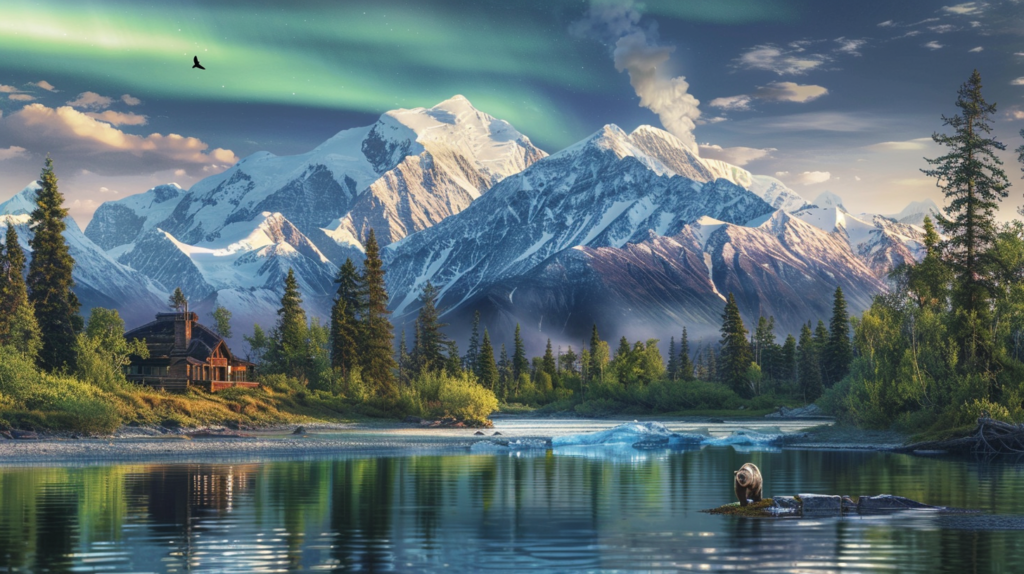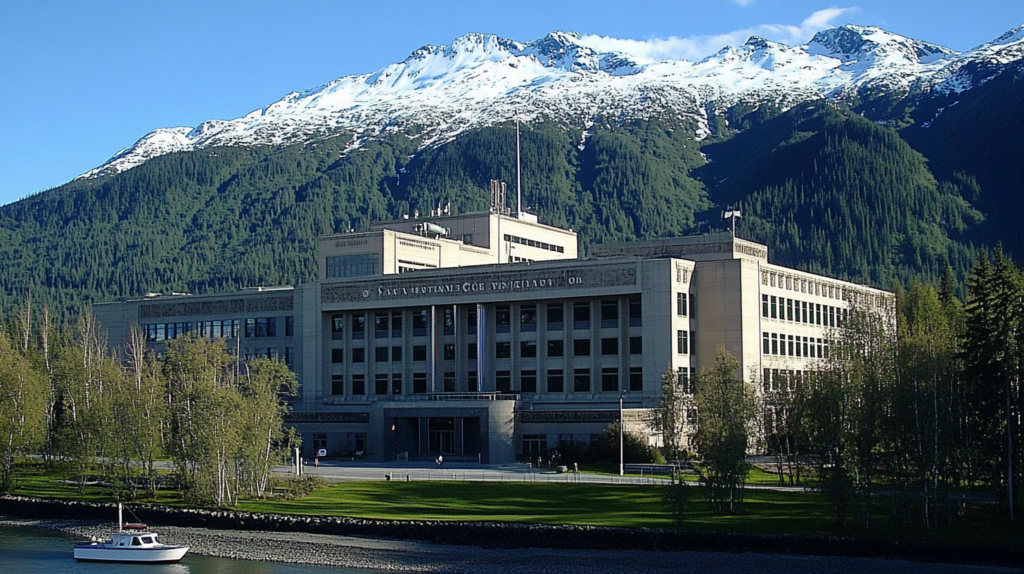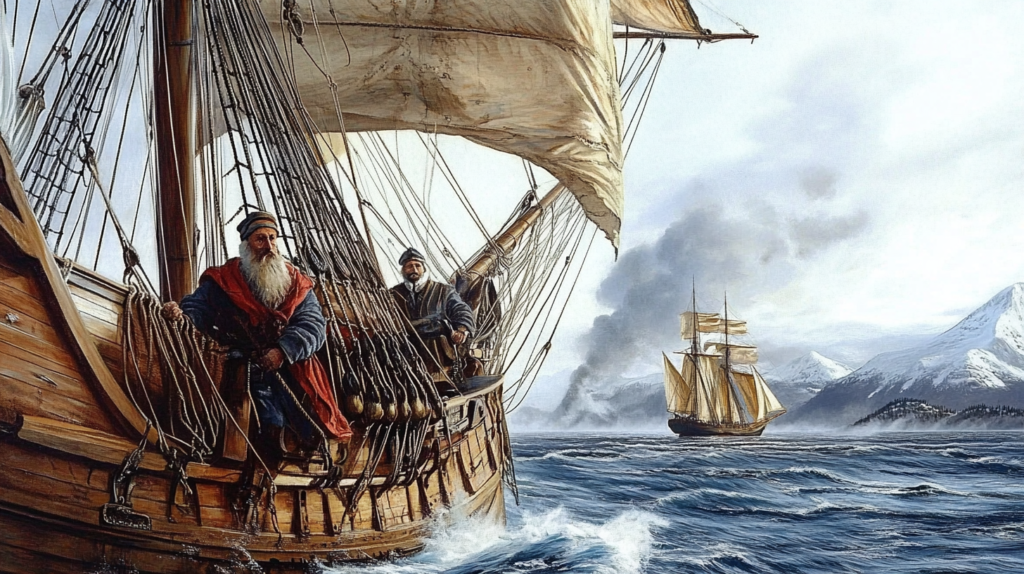
The Last Frontier
Geography
Alaska, the largest state in the United States, is a land of extremes and breathtaking beauty. Spanning over 663,000 square miles, it features diverse landscapes, including towering mountain ranges like the Alaska Range (home to Denali, North America’s highest peak), vast tundras, sprawling glaciers, and over 6,600 miles of coastline. The state is bordered by Canada to the east, the Arctic Ocean to the north, and the Pacific Ocean to the south and west, making it a strategic and geographically unique location.
History
Alaska’s history is as vast as its landscapes. Indigenous peoples, including the Iñupiat, Yupik, Aleut, and Tlingit, have inhabited the region for over 10,000 years, cultivating rich cultures and traditions. Russian explorers arrived in the 18th century, establishing settlements and fur trading posts. In 1867, the United States purchased Alaska from Russia for $7.2 million in a deal known as “Seward’s Folly,” which later proved to be a bargain following the discovery of gold and oil. Alaska became the 49th state in 1959, marking a new chapter in its storied history.
Economy
Alaska’s economy is driven by its abundant natural resources. Oil and gas production are the backbone of the state’s economy, with the Trans-Alaska Pipeline System serving as a critical infrastructure component. Fishing and seafood processing also play a significant role, as Alaska’s waters are some of the most productive in the world. Tourism is another major industry, with visitors drawn to the state’s national parks, wildlife, and unique cultural experiences. Additionally, Alaska’s strategic location has made it a hub for military and aerospace activities.
Nature
Alaska is a paradise for nature lovers. Its pristine wilderness is home to an incredible array of wildlife, including grizzly bears, moose, caribou, bald eagles, and humpback whales. The state boasts 8 national parks, including Denali, Kenai Fjords, and Glacier Bay, offering unparalleled opportunities for hiking, kayaking, and wildlife viewing. Alaska is also famous for its natural phenomena, such as the Northern Lights (Aurora Borealis) and the Midnight Sun, which provide unforgettable experiences for residents and visitors alike.
Population
Despite its massive size, Alaska is one of the least densely populated states in the U.S., with a population of just over 730,000 people. The majority of residents live in urban areas like Anchorage, Fairbanks, and Juneau (the state capital), while smaller communities are scattered across the vast wilderness. Alaska is also home to a significant Indigenous population, with over 15% of residents identifying as Alaska Native or American Indian. The state’s diverse population contributes to its vibrant cultural tapestry, blending modern life with ancient traditions.

Political Landscape
Electoral System Innovation Alaska has pioneered a unique voting system that sets it apart from all other states. In 2020, voters approved a combination of open primaries and ranked-choice voting for general elections. In this system, all candidates appear on a single primary ballot regardless of party, and the top four advance to the general election. In the general election, voters rank their choices, creating a system that can reward moderate candidates and coalition-building.
Resource Politics and the Permanent Fund Perhaps the most unique aspect of Alaska politics is the Permanent Fund, established in 1976. This sovereign wealth fund, funded by oil revenues, not only provides annual dividend payments to residents but fundamentally shapes political discourse. Every election cycle and legislative session involves intense debates about the size of the dividend payment, creating a direct link between resource management and citizen benefits that exists nowhere else in the US.
Legislative Structure and Coalitions Alaska’s legislature frequently operates differently from the typical partisan divide seen in other states. The state House has often been governed by cross-party coalitions, with moderate Republicans sometimes joining Democrats to form majority coalitions. This creates a more fluid political environment than the rigid party-line governance seen in most other states.
Native Influence and Rural-Urban Divide Alaska’s political structure gives unique consideration to its Native populations. The Alaska Native Claims Settlement Act created Native corporations that wield significant political influence. Rural communities, many predominantly Native, have special protections and considerations in state law, particularly regarding subsistence hunting and fishing rights. This creates a complex balancing act between urban and rural interests that shapes policy decisions.
Executive Branch Dynamics The governor of Alaska has unusually strong line-item veto powers, which have been used dramatically in recent years to influence budget decisions. The executive branch also has unique responsibilities regarding natural resource management, with specialized departments overseeing oil, gas, and fishing industries that are central to the state’s economy.
Local Governance Structure Alaska’s local government system is distinct, using boroughs rather than counties, with some areas remaining unincorporated in the “unorganized borough.” This creates different dynamics between state and local governance than seen in other states, particularly in rural areas.
Regulatory Independence Alaska maintains independent regulatory systems for many of its key industries, particularly fishing and oil extraction. The state’s Department of Natural Resources and Fish and Game Department have unusual autonomy and authority compared to similar agencies in other states.
Ballot Initiative Process While not unique to Alaska, the state’s ballot initiative process has been particularly influential in shaping policy. Major reforms, including the recent voting system changes, have come through direct democracy rather than legislative action.
Federal-State Relations Alaska’s relationship with the federal government is distinctive due to the large percentage of federally owned land and the unique provisions of the Alaska National Interest Lands Conservation Act. This creates ongoing tensions and negotiations over land use, resource extraction, and environmental protection that shape state politics.
Would you like me to expand on any of these aspects? Each has its own fascinating details and implications for how politics actually works in Alaska.
Frontier Spirits: The Cultural Parallels Between Jutland and Alaska

A Tale of Two Frontiers
Despite being separated by thousands of miles, Jutland (Jylland) and Alaska share remarkable similarities in their frontier mentality and cultural characteristics. Both regions have historically functioned as edges of civilization, shaping their inhabitants’ worldview and relationship with authority.
The Spirit of Self-Reliance
In both Jutland and Alaska, the sparse population density has fostered a deep-rooted culture of self-reliance. Jutland’s farmers, known as “hedefolk” (heath people), historically carved out an existence from the harsh, windswept heathlands, much as Alaskans have learned to thrive in their challenging environment. This physical isolation has created communities that pride themselves on their ability to solve problems independently, often viewing outside intervention with skepticism.
Relationship with Central Authority
Both regions share a complex relationship with their respective central governments. In Jutland, there’s a historical tendency to view Copenhagen’s authority with reservation, reflected in the local saying “Der er langt til København” (It’s a long way to Copenhagen) – both a geographical fact and a cultural statement. This mirrors Alaska’s “Don’t Tread on Me” attitude toward federal oversight from Washington, D.C.
Resource-Based Independence
The economies of both regions have traditionally relied on natural resource extraction and management. Jutland’s agricultural heritage and fishing industry parallel Alaska’s relationship with its fishing grounds and natural resources. This economic self-sufficiency has reinforced their independent streak and resistance to external control.
Cultural Conservation
Both regions serve as strongholds of traditional cultural practices. Just as Alaska’s communities maintain strong ties to indigenous traditions and subsistence lifestyles, Jutland has preserved distinct dialects, customs, and cultural practices that set it apart from the more urbanized eastern Denmark.
Weather-Hardened Pragmatism
The challenging weather conditions in both regions have fostered a similar pragmatic approach to life. While Alaska faces extreme cold and darkness, Jutland contends with harsh North Sea winds and long, dark winters. This has cultivated a shared appreciation for practical solutions and a certain stoic resilience among their populations.
The Power of Community
Despite their individualistic tendencies, both regions have developed strong community bonds. The harsh conditions and isolation have led to tight-knit communities where neighbors help neighbors, even while maintaining their fierce independence.
This parallel existence – of communities that value independence while recognizing the need for interdependence – creates a fascinating bridge between these two distant frontiers, suggesting that geography and circumstance can forge similar cultural responses across vast distances.
The Historical Link:

From Jutland to Alaska: The Legacy of Vitus Bering
The story of how the Danish peninsula of Jutland became unexpectedly linked to Alaska begins in the port city of Horsens, where Vitus Bering was born in 1681. Growing up in this coastal region of Jutland, Bering was surrounded by maritime culture and the rich Viking heritage that had long defined this peninsula between the North and Baltic Seas.
Bering’s early life in Jutland shaped his destiny as a maritime explorer. The peninsula’s strategic location and seafaring traditions provided the perfect backdrop for nurturing his nautical ambitions. Like many Danish sailors before him, Bering was drawn to the opportunities offered by the expanding Russian Empire, and in 1703, he joined the Russian Navy under Tsar Peter the Great.
The connection between Jutland and Alaska materialized through what would become known as the Great Northern Expedition (1733-1743). Commissioned by the Russian Empire, Bering led this ambitious venture to explore the northern reaches of the Pacific Ocean. During these voyages, he became the first European to discover Alaska from the west, navigating through the strait that would later bear his name – the Bering Strait.
The waters that Bering charted would prove crucial in establishing Russia’s claims to Alaska, ultimately leading to the region becoming known as Russian America. Today, the Bering Sea, Bering Strait, and Bering Island stand as permanent reminders of how a son of Jutland helped map the Alaskan frontier. These geographic features now serve as tangible links between his birthplace in eastern Jutland and the vast wilderness of Alaska.
Ironically, while Bering’s expeditions would open up Alaska to European exploration and eventually lead to Russian colonization, he never returned to his native Jutland. He died in 1741 on what would later be named Bering Island, thousands of miles from the Danish shores where his journey began. Yet his legacy created an enduring connection between these two distant regions: the pastoral landscapes of Jutland and the rugged wilderness of Alaska, linked forever through the achievements of one intrepid explorer.